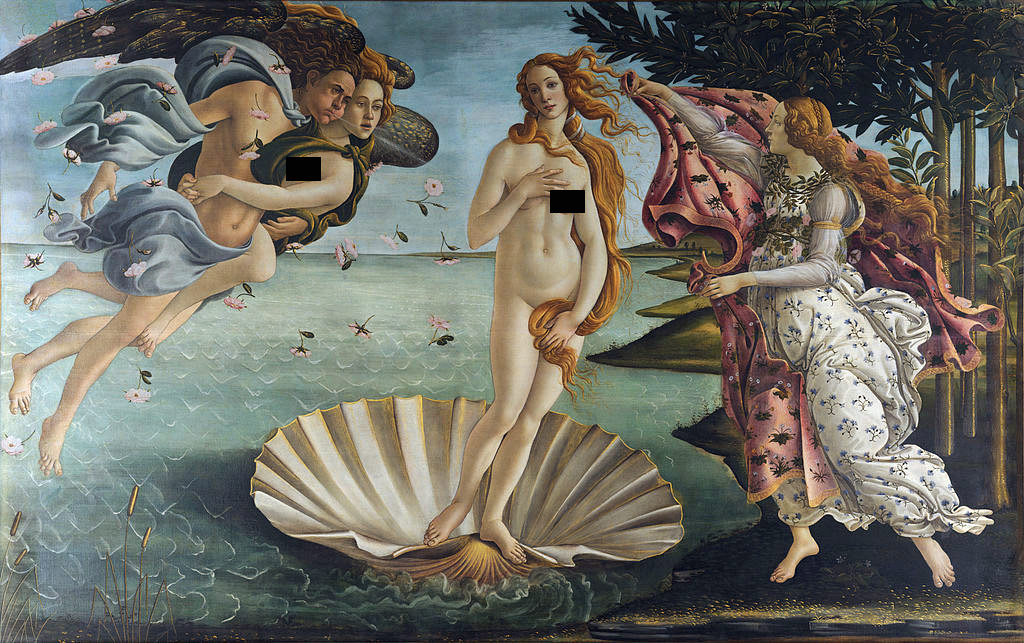| The Birth of Venus | |
|---|---|
 |
|
| Artist | Sandro Botticelli |
| Year | c. 1486 |
| Medium | Tempera on canvas |
| Location | Uffizi, Florence |
| Dimensions | 67.9 in × 109.6 in |
| 172.5 cm × 278.5 cm | |
| Famous Paintings by Botticelli | |
| Fortitude | |
| Adoration of the Magi | |
| The Birth of Venus | |
| Primavera | |
| Cestello Annunciation | |
| Saint Augustine | |
| Venus and Mars | |
| The Mystical Nativity | |
| Temptations of Christ | |
| Complete Works |
More than 500 years after its creation, The Birth of Venus by Sandro Botticelli is one of the most iconic paintings ever produced, and remains among the most renowned and priceless masterpieces in the world.
Painted in 1486, The Birth of Venus has been the subject of endless intellectual speculation and interpretations of meaning.
The painting depicts a voluptuous nude female standing gracefully upon a large seashell which appears to emerge onto shore from the ocean. To her left is a male angel floating in the air and clutching a woman in a tight embrace. To the right of the Venus is another woman in flowing garments, appearing to hail the arrival of the “goddess.”
The Meaning Behind the Painting
It’s a gorgeous vision, certainly, and stunning to behold. But art critics and historians can’t help but ponder the greater meaning behind The Birth of Venus. Perhaps the most dominant view is that the painting was inspired by Neoplatonic thought. This latter body of philosophy was a revival and slight reinterpretation of the works of the ancient Greek philosopher Plato.
In the Middle Ages, intellectuals across Europe were rediscovering the works of the ancient Greeks with great enthusiasm after the long oppression of the Dark Ages. They were also applying their own meanings to what the Greek masters were talking about. Artists such as Botticelli were inspired by this and also Greek mythology. This was a break from the long dominance of art based on Christian themes and the dogma of the Catholic Church.
Physical Beauty and Intellectual Love
According to Neoplatonism, great physical beauty was a direct springboard to spiritual beauty and intellectual love. The stunning Venus perched on a half-shell is a ravishing beauty with lengthy locks of luxurious reddish-blonde hair. Her skin is pale and her stance is rather demure. Her head is tilted coquettishly. She shyly covers her genitals with a flourish of her tresses. Her right hand is poised at her breasts.
Those who viewed the painting in the 15th Century may have had their minds lifted to the ideal of Plato’s higher forms of love, as prompted by the physical beauty of the female body.
Inspired by Lorenzo de Medici
Over the years, many have offered other views, and some have even questioned the predominance of Neoplatonic thought as being influential on the scene of late 1400s Italy. Thus, others have suggested that the painting is about Lorenzo de’ Medici, the man who commissioned the painting. The images of the painting are purported to be a symbolic reflection of de Medici’s virtues.
Lorenzo de’ Medici was a powerful and extremely wealthy Italian statesman. In effect, he was the ruler of the Florentine Republic. The Medici family itself had gained great wealth in their era as bankers and captains of industry. They controlled just about every aspect of local society through their monopoly on the monetary system.
Lorenzo de’ Medici was an extreme lover of the arts, and contributed huge portions of his great wealth toward commissioning paintings by the greatest artistic masters of the day, one of whom was Botticelli.
Botticelli’s Biography
Botticelli’s full name was Alessandro di Mariano di Vanni Filipepi, but he was commonly known as Sandro. His work is assigned to the “Florentine school” and he is known for the “linear grace” of his work. He was born around 1445 and achieved his peak in the decade of 1480s when he produced The Birth of Venus, and another masterpiece, Primavera.
By 1502, Botticelli’s skill, career and talent was considered to have faded, his best years well behind him. However, with works such as The Birth of Venus under his name, Botticelli had gained an enduring reputation as one of the great masters of the “Golden Age” of Renaissance painting. Although his works fell out of favor among art experts in the 19th Century, Botticelli has never really lost his position as a timeless genius.
It should be noted that the interpretation of The Birth of Venus as extolling the virtues of Lorenzo de’ Medici is not widely accepted. That the painting was inspired by Plato simply makes more sense. The images in the painting lend themselves much more readily to a Neoplatonic view.
As we all know, he meaning of art is ultimately in the eye of the beholder, and the greatest works invite multiple interpretations – with none of them necessarily being completely right or wrong.
Today, The Birth of Venus is held in the Uffizi Gallery in Florence, Italy.